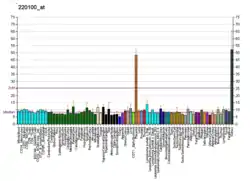SLC22A11
Solute carrier family 22 member 11 is a protein that in humans is encoded by the SLC22A11 gene.[3][4][5][6]
The protein encoded by this gene is involved in the sodium-independent transport and excretion of organic anions, some of which are potentially toxic. The encoded protein is an integral membrane protein and is found mainly in the kidney and in the placenta, where it may act to prevent potentially harmful organic anions from reaching the fetus.[6]
See also
References
- GRCh38: Ensembl release 89: ENSG00000168065 - Ensembl, May 2017
- "Human PubMed Reference:". National Center for Biotechnology Information, U.S. National Library of Medicine.
- Cha SH, Sekine T, Kusuhara H, Yu E, Kim JY, Kim DK, Sugiyama Y, Kanai Y, Endou H (Mar 2000). "Molecular cloning and characterization of multispecific organic anion transporter 4 expressed in the placenta". J Biol Chem. 275 (6): 4507–12. doi:10.1074/jbc.275.6.4507. PMID 10660625.
- Zhou F, Xu W, Hong M, Pan Z, Sinko PJ, Ma J, You G (Feb 2005). "The role of N-linked glycosylation in protein folding, membrane targeting, and substrate binding of human organic anion transporter hOAT4". Mol Pharmacol. 67 (3): 868–76. doi:10.1124/mol.104.007583. PMID 15576633. S2CID 7477352.
- Hagos Y, Stein D, Ugele B, Burckhardt G, Bahn A (Jan 2007). "Human renal organic anion transporter 4 operates as an asymmetric urate transporter". J Am Soc Nephrol. 18 (2): 430–9. doi:10.1681/ASN.2006040415. PMID 17229912.
- "Entrez Gene: SLC22A11 solute carrier family 22 (organic anion/cation transporter), member 11".
Further reading
- Maruyama K, Sugano S (1994). "Oligo-capping: a simple method to replace the cap structure of eukaryotic mRNAs with oligoribonucleotides". Gene. 138 (1–2): 171–4. doi:10.1016/0378-1119(94)90802-8. PMID 8125298.
- Suzuki Y, Yoshitomo-Nakagawa K, Maruyama K, et al. (1997). "Construction and characterization of a full length-enriched and a 5'-end-enriched cDNA library". Gene. 200 (1–2): 149–56. doi:10.1016/S0378-1119(97)00411-3. PMID 9373149.
- Sun W, Wu RR, van Poelje PD, Erion MD (2001). "Isolation of a family of organic anion transporters from human liver and kidney". Biochem. Biophys. Res. Commun. 283 (2): 417–22. doi:10.1006/bbrc.2001.4774. PMID 11327718.
- Babu E, Takeda M, Narikawa S, et al. (2002). "Human organic anion transporters mediate the transport of tetracycline". Jpn. J. Pharmacol. 88 (1): 69–76. doi:10.1254/jjp.88.69. PMID 11855680.
- Kimura H, Takeda M, Narikawa S, et al. (2002). "Human organic anion transporters and human organic cation transporters mediate renal transport of prostaglandins". J. Pharmacol. Exp. Ther. 301 (1): 293–8. doi:10.1124/jpet.301.1.293. PMID 11907186.
- Takeda M, Babu E, Narikawa S, Endou H (2002). "Interaction of human organic anion transporters with various cephalosporin antibiotics". Eur. J. Pharmacol. 438 (3): 137–42. doi:10.1016/S0014-2999(02)01306-7. PMID 11909604.
- Enomoto A, Takeda M, Shimoda M, et al. (2002). "Interaction of human organic anion transporters 2 and 4 with organic anion transport inhibitors". J. Pharmacol. Exp. Ther. 301 (3): 797–802. doi:10.1124/jpet.301.3.797. PMID 12023506.
- Enomoto A, Kimura H, Chairoungdua A, et al. (2002). "Molecular identification of a renal urate anion exchanger that regulates blood urate levels". Nature. 417 (6887): 447–52. doi:10.1038/nature742. PMID 12024214. S2CID 4417844.
- Strausberg RL, Feingold EA, Grouse LH, et al. (2003). "Generation and initial analysis of more than 15,000 full-length human and mouse cDNA sequences". Proc. Natl. Acad. Sci. U.S.A. 99 (26): 16899–903. doi:10.1073/pnas.242603899. PMC 139241. PMID 12477932.
- Ota T, Suzuki Y, Nishikawa T, et al. (2004). "Complete sequencing and characterization of 21,243 full-length human cDNAs". Nat. Genet. 36 (1): 40–5. doi:10.1038/ng1285. PMID 14702039.
- Zhou F, Tanaka K, Pan Z, et al. (2004). "The role of glycine residues in the function of human organic anion transporter 4". Mol. Pharmacol. 65 (5): 1141–7. doi:10.1124/mol.65.5.1141. PMID 15102942.
- Zhou F, Pan Z, Ma J, You G (2005). "Mutational analysis of histidine residues in human organic anion transporter 4 (hOAT4)". Biochem. J. 384 (Pt 1): 87–92. doi:10.1042/BJ20040751. PMC 1134091. PMID 15291761.
- Gerhard DS, Wagner L, Feingold EA, et al. (2004). "The Status, Quality, and Expansion of the NIH Full-Length cDNA Project: The Mammalian Gene Collection (MGC)". Genome Res. 14 (10B): 2121–7. doi:10.1101/gr.2596504. PMC 528928. PMID 15489334.
- Taylor TD, Noguchi H, Totoki Y, et al. (2006). "Human chromosome 11 DNA sequence and analysis including novel gene identification". Nature. 440 (7083): 497–500. doi:10.1038/nature04632. PMID 16554811.
This article incorporates text from the United States National Library of Medicine, which is in the public domain.
This article is issued from Wikipedia. The text is licensed under Creative Commons - Attribution - Sharealike. Additional terms may apply for the media files.


